CHAPTER III.
KILLARNEY AND ABOUT THERE
KILLARNEY is a
considerable town, rather prim and staid and too offensively well
kept to be wholly appealing. It is by no means handsome of itself,
nor are its public buildings.
The chief industry is
catering, in one form or another, to the largely increasing number of
tourists who are constantly flocking thither.
The value of Killarney,
as a name of sentimental and romantic interest, lies in its
association with its lakes and the abounding wealth of natural
beauties around about it.
Torc Mountain and
waterfall, Muckross, Cloghereen, the Gap of Dunloe and its castle,
the upper, middle, and lower lakes, Purple Mountain, Black Valley,
Eagle’s Nest, and Innisfallen are all names with which to call up
ever living memories of the fairies of legend and folk-lore, and of
the more real personages of history and romance.
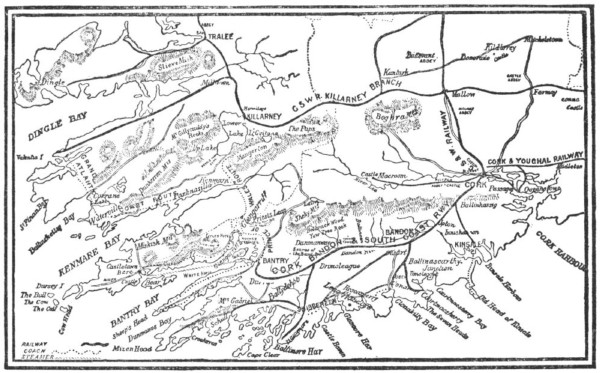
KILLARNEY AND ABOUT THERE
To recount them all, or
even to categorically enumerate them, would be impossible here.
There is but one way to
encompass them in a manner at all satisfactory, and that is to make
Killarney a centre, and radiate one’s journeys therefrom for as
extended a period as circumstances will allow. The guide-books set
forth the attractions and the ways and means in the usual
conventional manner, but it is useless to expect any real help from
them.
The true gem of
Killarney’s many charms is without question Lough Leane and
Innisfallen (Monk’s Robe Island), which lies embosomed in the lower
lake.
Yeats, the Irish poet,
spent the full force of his lyric genius in the verses which he wrote
with this entrancing isle for their motive.
Robert Louis Stevenson is
reported to have said that, of all modern poets, none has struck the
responsive chord of imagination as did this sweet singer with the
following lines: “And I shall have some
peace there,
For peace comes dropping
slow,
Dropping from the veils
of the morning
To where the cricket
sings;
There midnight’s all a
glimmer
And noon a purple glow,
And evening full of the
linnet’s wings.
“I will arise and go
now,
For always, night or day,
I hear lake water
lapping,
With low sounds by the
shore;
While I stand on the
roadway,
Or on the pavements gray,
I hear it in the deep
heart’s core.”
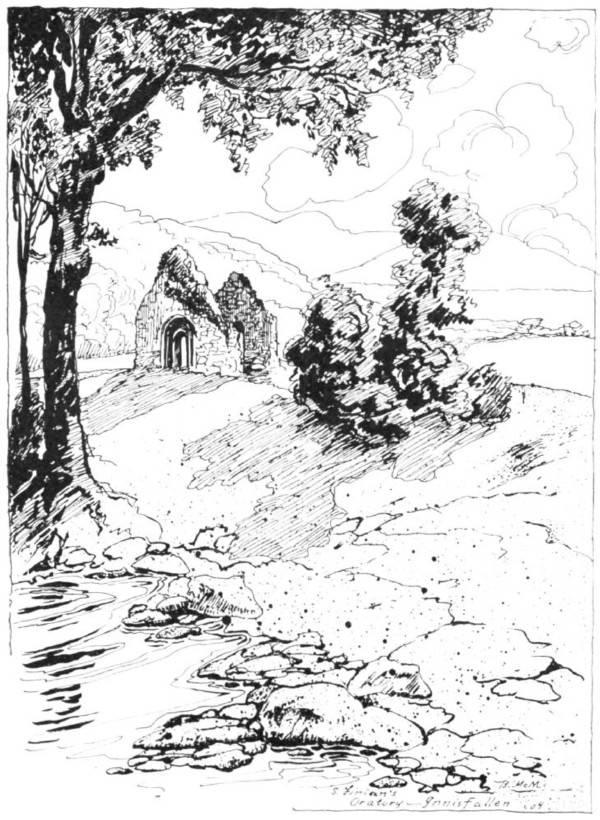
ST. FINIAN’S ORATORY,
INNISFALLEN.
Moore’s description is
perhaps as appropriate, but it is no more beautiful:
“Sweet Innisfallen,
fare thee well,
May calm and sunshine
long be thine!
How fair thou art let
others tell, —
To feel how fair shall
long be mine.”
From Glengarriff to
Killarney via
Kenmare is a long-drawn sweetness of prospect, which it is perhaps
impossible to duplicate for its sentimental charm, — an ability to
appreciate which belongs to us all, even if only to a limited extent.
The road from County Cork
to County Kerry — and one journeys only by road from Bantry Bay to
Dingle Bay, via
Kenmare and Killarney, the age of steam not yet having arrived at
these parts — winds fascinatingly up and down hill and dale, diving
suddenly through a tunnelled rock, when a transformation takes place,
and one leaves the ruggedness and freshness of Bantry Bay for the
more or less humid fairy-land of the region about Killarney. The view
ahead is peculiarly grand in its contrast with that left behind. Down
the beetling precipices along which the road is clinging to its
sterile sides, one traces the valley beneath until it blends with the
silvery surface of Kenmare River. From Kenmare, the way to Killarney
is by the “Windy Gap.” Beneath lies an extensive valley, and
beyond is the Black Valley. Farther on are the skylines of the
mountains which encompass the wild and dark Gap of Dunloe; and,
farther still, will be observed the more jagged outlines of
“MacGillicuddy’s Reeks.” Soon one beholds the first view of the
beauties of far-famed Killarney, the immense valley in which repose
the three lakes, — the upper, lower, and middle, with their
numerous islets. En
route
from Kenmare to Killarney, one first comes to Muckross Abbey and
Demesne, of which Sir Walter Scott has said: “Art could make
another Versailles; it could not make another Muckross.” This is
characteristic of Sir Walter and his fine sentiment; but, as Muckross
is suggestive of nothing ever heard or thought of at Versailles, the
comparison is truly odious.
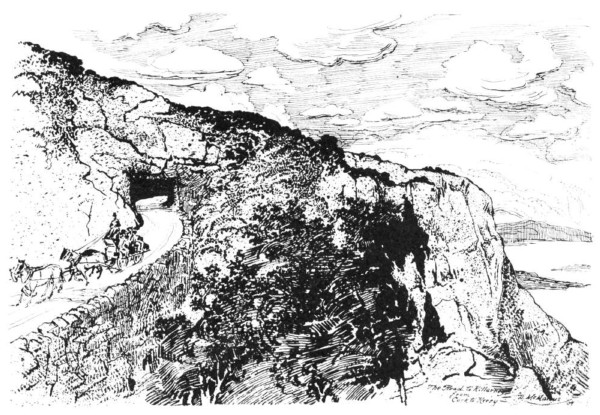
ON THE ROAD FROM CORK TO
KERRY.
Muckross is charming. It
is thoroughly Irish; and reeks of the native soil and its people,
wherein is its value to the traveller.
The scenery around about
Muckross is very beautiful, but its ruined abbey is the great
architectural relic of all Ireland. The ruins consist of the abbey
and church, which was founded for the Order of Franciscans by
McCarthy Mor, Prince of Desmond, in 1340, on the site of an old
church which, in 1192, had been destroyed by fire. The remains of
several of this prince’s descendants are said to rest here. In the
choir is the vault of the ancient Irish sept., the McCarthys, the
memory of whom is preserved by a rude sculptured monument. Here also
rest the remains of the Irish chieftains or princes of the houses of
O’Sullivan Mor and the O’Donoghue. The great beauty of these
ruins lies in its gloomy cloisters, which are rendered still more
gloomy by the close proximity of a magnificent yew-tree of immense
size and bulk.
Killarney’s lakes are
irregular sheets of water lying in a basin at the foot of a very high
range of mountains, set with islands and begirt with rocky and wooded
heights. They are three in number; what is known as the upper, the
middle or Muckross Lake, and the lower lake, — the northernmost, —
more properly called Lough Leane. The middle lake is also called the
Torc. A winding stream, known as the Long Range, unites the different
bodies of water. The chief of the natural beauties of the Long Range
is the Eagle’s Nest, which rises sheer from the water’s edge
1,700 feet. The upper lake is the most beautiful of all, though the
smallest of the triad. It is studded with tiny islands and girt with
mountain peaks, bare and stern above, but clothed with rich foliage
at their base. The middle lake is also a beautiful, though more
extensive, sheet, and contains but four islands, as compared with
thirty in the lower lake and six in the upper.
The Colleen Bawn Caves —
reminiscent of Gerald Griffin’s story, “The Colleen Bawn,” and
Boucicault’s famous play of the same name — are also in the
immediate neighbourhood of the middle lake. Torc Cascade and Torc
Mountain lies just to the southward, and is justly famed as one of
the brilliant beauties of the region, as it falls in numerous
sections over the broken rock to fall finally in a precipitous
torrent of foam to its ravine-bed below.
Ross Castle, like
Muckross Abbey, is one of Killarney’s chief picturesque ruins. It
is on an island in the lower lake, and was built ages agone by the
O’Donoghues. It was the last castle in Munster to surrender in the
wars of the seventeenth century, giving in only when General Ludlow
and his “ships-of-war,” as his narrative called them, surrounded
it. MacGillicuddy’s Reeks lie farthest to the westward in the
Killarney region. The name of this stern and jagged range sounds
somewhat humourous, and in no way suggests the majesty and splendour
of these hills; for they resemble the great mountains of other parts
only by reason of their contrast with the low-lying land around their
bases. One portion, indeed, rises a matter of 3,400 feet, and forms
the most elevated peak in Ireland, grand and majestic, but, for all
that, not a great mountain, as is so often claimed by the proud
native. The celebrated Gap of Dunloe is far more deserving for its
natural scenic splendour, and, in its way, rivals anything in
Ireland.
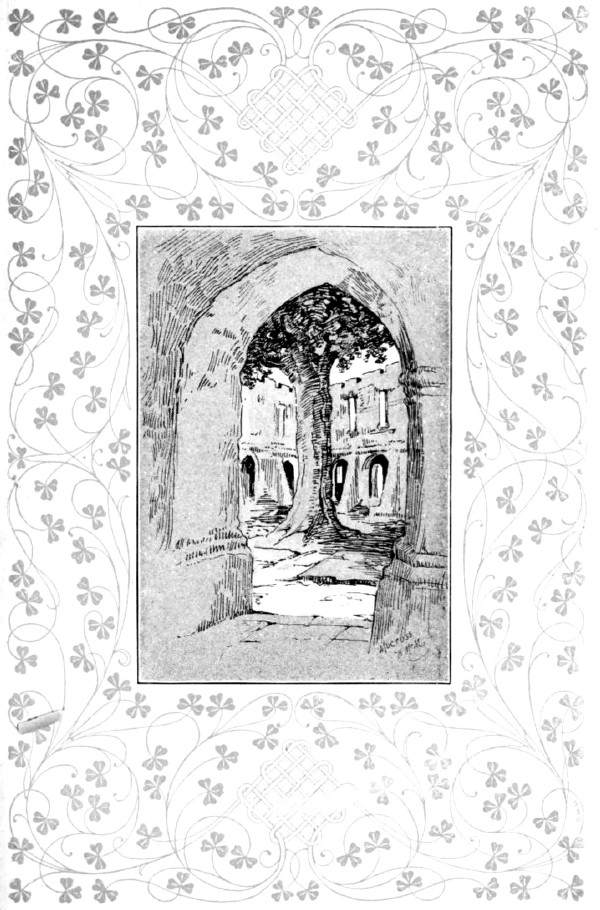
Cloisters of Muckross
Abbey
The popular method of
imbibing the charm of Dunloe is a combination of picnic, al
fresco
luncheons, and donkey-riding. This answers well enough for the
“tripper,” but is as unsatisfying to the real lover of nature as
an imitation Swiss châlet
set out in a London park, or a Japanese tea-garden built out of
bamboo poles from Africa.
The Gap of Dunloe is a
grand defile, perhaps five miles in length, which can only be
explored and truly enjoyed by a pilgrimage along its solitary and
rugged road on foot. Its scenic aspect is gloomy and grand, with
mirrored lakes, lofty mountains, and a thick undergrowth of heather
and ivy. It is, however, in no manner theatrical. Through this wild
glen ripples the river Lee, linking its five tiny lakes as with a
silver thread.
At the upper end of the
gap one emerges into “The Black Valley,” somewhat apocryphally
stated to be “a gloomy, depressing ravine.”
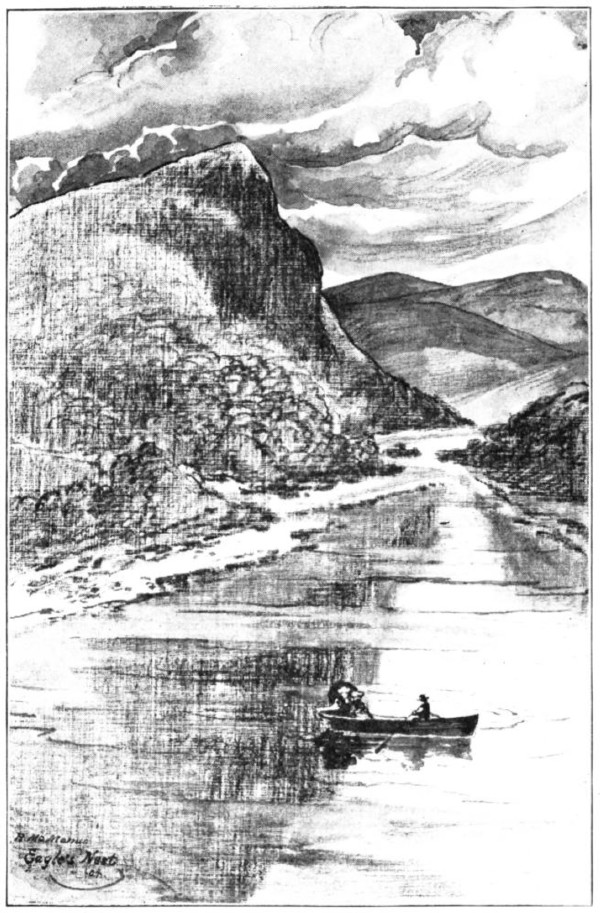
THE EAGLE’S NEST.
The sun, it appears, does
not shine down its length for long in the day, as it is flanked on
either side by precipitous hills. The average imagination will not,
however, conjure up any very dark suspicions with regard to its past,
judging from the aspect of the valley between the hours of nine in
the morning and two in the afternoon. Both before and after these
hours there is no sunlight; and, because of the dense, long-reaching
shadows which are projected across it, it was so named.
There is a good week’s
rambling here to spots already famed in history for their beauty; but
one must search them out for himself as a personal experience.
England’s poet laureate
has written in praise of Killarney in a fashion which should please
his severest critics, those who have mourned the lack of a single
thought in his verse. This is certainly not true with regard to his
prose, which, in the following lines, so justly and appropriately
describes the charm of South-west Ireland:
“Vegetation, at once
robust and graceful, is but the fringe and decoration of that
enchanting district. The tender grace of wood and water is set in a
framework of hills, — now stern, now ineffably gentle; now dimpling
with smiles, now frowning and rugged with impending storm; now
muffled and mysterious with mist, only to gaze out on you again with
clear and candid sunshine. Here the trout leaps, there the eagle
soars; and there, beyond, the wild deer dash through the arbutus
coverts, through which they have come to the margin of the lake to
drink, and, scared by your footstep or your oar, are away back to the
crosiered bracken or heather-covered moorland. But the first, the
final, the deepest and most enduring impression of Killarney is that
of beauty unspeakably tender, which puts on at times a garb of
grandeur and a look of awe, only in order to heighten by passing
contrast the sense of soft, insinuating loveliness. How the
missel-thrushes sing, as well they may! How the streams and runnels
gurgle and leap and laugh! For the sound of journeying water is never
out of your ears; the feeling of the moist, the fresh, the vernal is
never out of your heart.... There is nothing in England or Scotland
as beautiful as Killarney; ... and, if mountain, wood, and water,
harmoniously blent, constitute the most perfect and adequate
loveliness that nature presents, it surely must be owned that it has,
all the world over, no superior.”
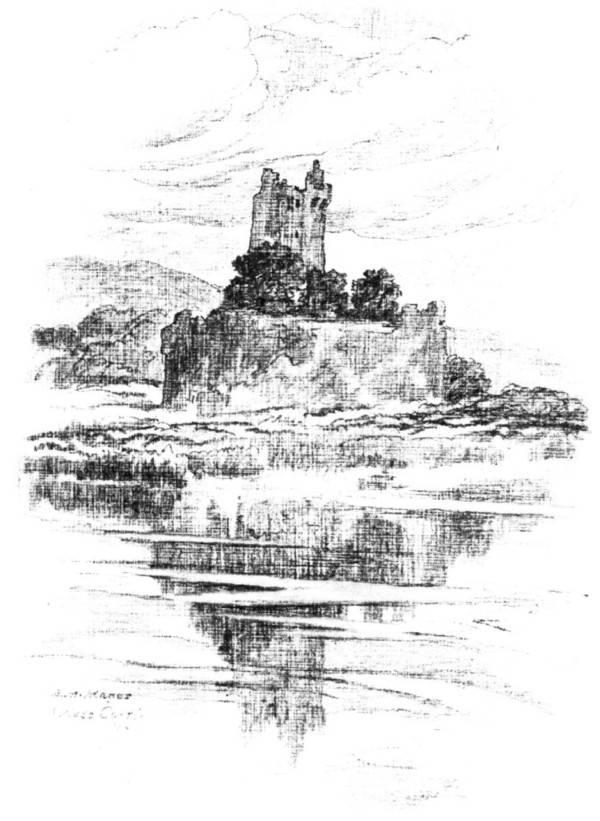
ROSS CASTLE
|

